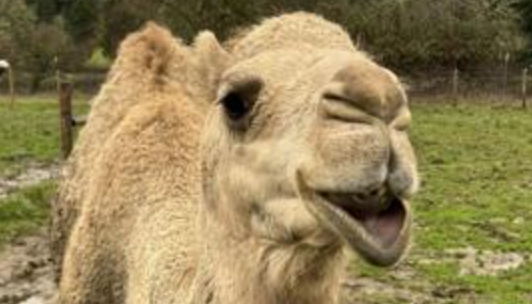Yoncalla farm gets over the hump by getting help from camels
Published 5:00 am Sunday, May 5, 2024

- One of the residents at the Pacific Northwest Camels in Yoncalla gets up close and personal with the camera.
It’s an unsuspecting animal to be found in the Pacific Northwest. The large animal with humps can be found in Yoncalla — and across the country.
Kyle McGranahan, owner of Pacific Northwest Camels in Yoncalla, said, “A lot of people don’t realize that they’re not exotic animals. They’re not a well-known animal for people to own.”
He said camels, along with llamas and alpacas, belong to the camelids family. But camels unlike their “cousins” — the llama and alpaca — are not considered exotic by the United States Department of Agriculture — yet.
The dromedary camel, the kind he has, originated in North America, hence their domestic status.
Over the last couple of years, the USDA has been urging to deem the domestic camel to be classified as exotic, according to McGranahan.
If this approval happens it will mean all camels would be only usable as “farm pets.” McGranahan would no longer be able to run his commercial camel business, and others couldn’t sell camel milk products.
Not many farms with camels can be found in Oregon. Frog Pond Farm LLC is located in Wilsonville, and across from the Columbia River from The Dalles, in Washington, is Schreiner Farms. West Coast Camels LLC in Pacific City was dissolved in 2022.
McGranahan said because no particular licensing is required to have the domestic animal, in his 18 years in the industry, he’s seen a boom in camel farms, unlike the decrease in exotic animal farms in the state.
Exotic animals include ostriches, llamas and alpacas.
As more animals become deemed exotic, or for those already in that category, exotic animal farms in Oregon have plummeted. In the past 20 years, exotic animal farms have taken a steep decrease in the state, according to the recent Census of Agriculture data.
McGranahan said the most recent census data for a camel count in the country showed 4,300 in 2018.
There were seven farms in Douglas County with “other livestock” in 2022, which decreased from 15 in 2002.
Michael Lehman, the president of the American Ostrich Association and owner of Central Oregon Ostrich, said in an interview with OPB, “There was a huge, huge push to bring ostrich into the United States as the next big red meat, and unfortunately there was a lot of money behind it. It was a big speculation. It failed rather dramatically.”
As reported by the Washington Post, the number of ostriches raised in the U.S. has dropped 83% in the last two decades.
“Everything blew out the window,” Lehman said in an interview with OPB. “In order to farm them, you have to farm them as a wild species. You can’t just push them into Western farming practices.”
Other animals, such as llamas, commonly used for companionship rather than as a food source, have similarly declined in Oregon. According to the census data, Oregon had an inventory of 13,311 llamas in 2002, compared to 2,085 in 2022.
There was an inventory of 52 “other livestock” in Oregon in 2022, a decrease of 236 from 2002.
McGranahan uses his camels for commercial and companionship purposes. Of his seven camels, a couple stay at his farms, a couple are available from March to October for rides at the Wildlife Safari in Winston and the others travel for events.
They love to work, he said.
At about 1,700 pounds, they are used as pack animals and can carry about half their weight. McGranahan hopes to continue training and doting on his camels to manage his farm and business.
McGranahan said, “We put smiles on peoples’ faces one hump at a time — dromedary style.”






